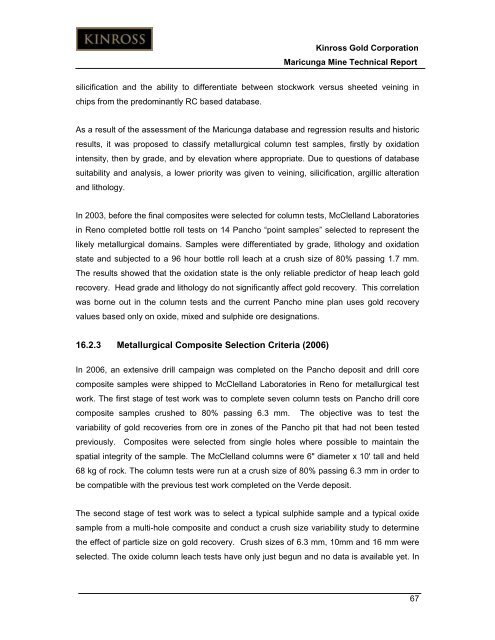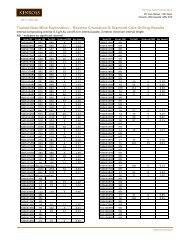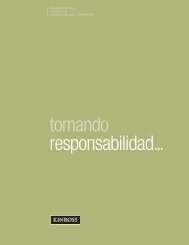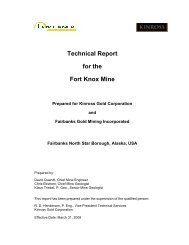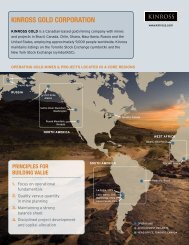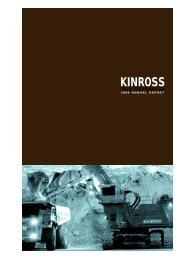Technical Report for the Maricunga Gold Mine - Kinross Gold
Technical Report for the Maricunga Gold Mine - Kinross Gold
Technical Report for the Maricunga Gold Mine - Kinross Gold
- No tags were found...
Create successful ePaper yourself
Turn your PDF publications into a flip-book with our unique Google optimized e-Paper software.
<strong>Kinross</strong> <strong>Gold</strong> Corporation<strong>Maricunga</strong> <strong>Mine</strong> <strong>Technical</strong> <strong>Report</strong>silicification and <strong>the</strong> ability to differentiate between stockwork versus sheeted veining inchips from <strong>the</strong> predominantly RC based database.As a result of <strong>the</strong> assessment of <strong>the</strong> <strong>Maricunga</strong> database and regression results and historicresults, it was proposed to classify metallurgical column test samples, firstly by oxidationintensity, <strong>the</strong>n by grade, and by elevation where appropriate. Due to questions of databasesuitability and analysis, a lower priority was given to veining, silicification, argillic alterationand lithology.In 2003, be<strong>for</strong>e <strong>the</strong> final composites were selected <strong>for</strong> column tests, McClelland Laboratoriesin Reno completed bottle roll tests on 14 Pancho “point samples” selected to represent <strong>the</strong>likely metallurgical domains. Samples were differentiated by grade, lithology and oxidationstate and subjected to a 96 hour bottle roll leach at a crush size of 80% passing 1.7 mm.The results showed that <strong>the</strong> oxidation state is <strong>the</strong> only reliable predictor of heap leach goldrecovery. Head grade and lithology do not significantly affect gold recovery. This correlationwas borne out in <strong>the</strong> column tests and <strong>the</strong> current Pancho mine plan uses gold recoveryvalues based only on oxide, mixed and sulphide ore designations.16.2.3 Metallurgical Composite Selection Criteria (2006)In 2006, an extensive drill campaign was completed on <strong>the</strong> Pancho deposit and drill corecomposite samples were shipped to McClelland Laboratories in Reno <strong>for</strong> metallurgical testwork. The first stage of test work was to complete seven column tests on Pancho drill corecomposite samples crushed to 80% passing 6.3 mm. The objective was to test <strong>the</strong>variability of gold recoveries from ore in zones of <strong>the</strong> Pancho pit that had not been testedpreviously. Composites were selected from single holes where possible to maintain <strong>the</strong>spatial integrity of <strong>the</strong> sample. The McClelland columns were 6" diameter x 10' tall and held68 kg of rock. The column tests were run at a crush size of 80% passing 6.3 mm in order tobe compatible with <strong>the</strong> previous test work completed on <strong>the</strong> Verde deposit.The second stage of test work was to select a typical sulphide sample and a typical oxidesample from a multi-hole composite and conduct a crush size variability study to determine<strong>the</strong> effect of particle size on gold recovery. Crush sizes of 6.3 mm, 10mm and 16 mm wereselected. The oxide column leach tests have only just begun and no data is available yet. In67


